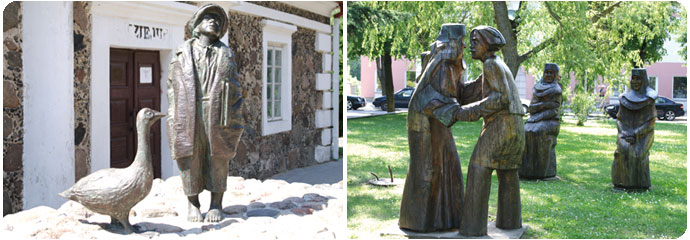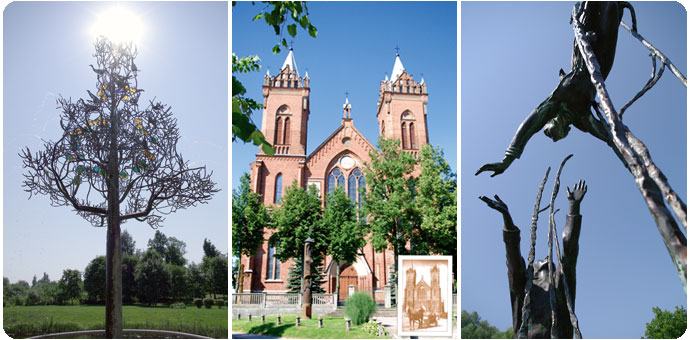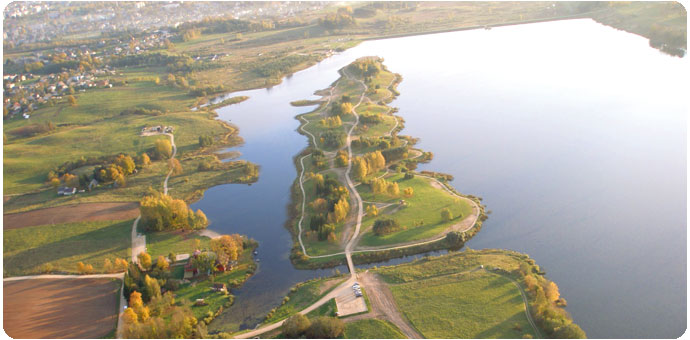 |
Sculpture “Shepherd”,
the author of the sculpture – H. Orakauskas |
Kupiškis Christ
Church of the Ascension
Wood sculpture composition “The wedding of Kupiškis residents”, the author of the
sculpture – H. Orakauskas |
KUPIŠKIS DISTRICT
Territory: 108 thousand ha, 58.89 % of them are covered by agriculture
areas, 25.37 % by forests, 2.4 % by water, 2.31 % by cities and villages, 1.76 % by
industrial companies and roads, 9.27 % by the areas of other purpose. The area of
Kupiškis city is 6425641 square meters.
Number of residents in the beginning of 2011: 21692 residents in the
territory of Kupiškis district municipality, 7833 of them live in Kupiškis city. The
district includes: 6 rural districts, 16 village posts and agencies, 1 Kupiškis district
post, 20 educational agencies (2 gymnasium, 2 secondary schools, 9 elemental schools, 1
primary school, 4 preschool educational agencies and 2 nonformal educational agencies
(music school, physical culture and sport center)), 1 technological and business school,
37 culture agencies, 11 catholic churches, 5 museums, 18 libraries, 39 architectural
monuments, 26 history monuments, 21 archeological monument, 22 medical treatment agencies.
“…Uvožokit jūs mono žodėlį…” – meaningfully sing the
residents of Kupiškis city. This folk poetic thought shows the maximum respect to
historical experience, homestead creation traditions and says: we want to communicate,
want to rub shoulders, really have to say something, want to noise the song – you just
listen!..
 |
| “The tree of Aistian world (life)”, the author of
the sculpture – H. Orakauskas |
Kupiškio Kristaus Žengimo į dangų bažnyčia |
|
VISITING OBJECTS
• We offer to begin the knowledge with Kupiškis land starting from Kupiškis
city. Kupiškis – little but individual and cozy North-East Lithuanian town,
the center of the administration of district municipality and culture. The town had
obtained its name from Kupos river and is established above the junction of this river and
Lėvens river. In historical sources - as the town of Lithuanian King Žygimantas the Old
– Kupiškis first was mentioned in 1529.
• Kupiškis ethnographic museum, established in old (1823) stonework
building of the school established by Čartoriskiai. There we are keeping the wealth of
material and spiritual culture cumulated by various generations.
The expositions of ethnography and folk art are waiting for you in the museum and the
halls of exhibitions include constantly organized exhibitions of art, folk art artists and
student’s creation works.
• Kupiškis city (Aukštupėnai) mound and Kupiškis Sea. Down high
hill of the mound the panorama of Kupiškis and its surroundings overlooks. Kupiškis
mound — the earliest nodus of the city. In 1984 after the banking of Lėvens River 828
ha Kupiškis Sea had formed – favorite relaxation place of Kupiškis residents and its
guests including annual fishermen competitions, various festivals, and regatta.
• “The tongue of Mother-in-law” (“Uošvės liežuvis”)
Lėvens pond is impressive not only by its size but also by the landscape. An impressive
island is located near Kupiškis, at the main Akštupėnai resort. It is called "The
tongue of Mother-in-law” for its unusual shape. The island can be entered through the
bridge after the arriving to Pajuodupė village. Other island is in Bagdoniai village.
Kupiškis sea regatta and ice-fishing competition call together not only the audience but
also the participants every year. Already become a tradition that an open Lithuanian
triathlon championship is organized at Lėvens pond also.
• Kupiškis Christ Church of the Ascension.
Kupiškis church is a real giant. Where never you arrive from to Kupiškis city at first
you could get an eyeful of proudly standing church from red bricks and climbing to heaven
by 21 crosses. The church is of neo-gothic style and is one of the biggest churches in
North-East Lithuania.
• In the house-museum of the originator of Lithuanian forestry sciences
professor Povilas Matulionis you will familiarize with his lifetime,
scientific and social activity.
• After visiting the square of Laurynas Stuoka-Gucevičius you will see
the monument for the architect Laurynas Stuoka-Gucevičius (the sculptor of the monument
– Vaclovas Krutinis) that was born in Kupiškis land and earned unforgettable honor for
Vilnius Cathedral. In 2001 the sculpture “Setting angel” of an artist and resident of
Kupiškis Henrikas Orakauskas was uncovered. A little bit further you will see the group
of wooden sculptures “The weddings of Kupiškis residents” created by the same artist
and reminding us folklore collective “The old weddings of Kupiškis residents” being
very popular for several decades.
• You should be engaged in the square of General Jonas Černius
appointed in 1998. The main focus of it is sculptural granite composition with the bust of
General Jonas Černius created by the sculptor Vaclovas Krutinis.
• In order to be familiarized with Kupiškis land you should visit Noriūnai
estate established inshore of Lėvens river and being mentioned in historical
sources already since 1665. This estate had belonged to Lithuanian grandees such as
Tiškevičiai, Tyzenhauzai, Oginskiai and Komarai. The palace was built by H.
Venclovavičius. The details of classicism and mannerism are typical for unusual plan of T
shape architecture of the palace in Lithuania. Although the remained neo-renaissance
mansion-house with Empire décor is junior by a long way – it was built in XIX century
by local craftsmen. Two dolomite towers characterize by their originality and provide the
features of romanticism for the ensemble. In the park of 10 hectares surrounding the
estate grows uncommon introductory trees. The ensemble of Palėvenė St. Dominic
church and Dominican monastery is situated on the right bank of Lėvens River.
This is the most prominent land building of sacral architecture. Also this is one of the
most authentic ensembles of baroques architecture in Lithuania remaining till our days.
Palėvenė church its history counts since 1676. The interior of the church includes
gorgeous altars of late baroque style and appointed in XVIII century, the pulpit of
uncommon shape, lodges decorated with the blazons of the church’s and monastery’s
founders.
• Komarai estate in Paulianka.
The noblemen Komarai had migrated to Lithuania from Padniestrė around 1481. The posterity
of Mykolas Komaras established in Palėvenė in 1645 had lived in Paulianka till World War
II. Currently the buildings of the palace built in XIX century are submitted to the
posterity of Komarai family.
• Terpeikiai oak.
5 kilometers away from Subačius to North-East an old Terpeikiai village is located. This
village in historical sources is being mentioned since 1596. In the homestead of Jonas
Jėčius grows an oak of the diameter of two meters – the monument of the nature.
IN ANTAŠAVA LAND:
• Adomas Petrauskas museum.
Uoginiai village is famous for unique museum that was established by a native
agriculturalist Adomas Petrauskas in his own homestead in 1969. The museum includes
expositions of domestic items, printings, folk sculptures, stands with photographs and
biographies of well-known people. The environment of the museum is decorated by the
collection of gathered field stones of impressive size and shapes and by millstones. There
green trees and bushes that were brought from the forest and planted by A. Petrauskas
himself.
• Picture gallery of artist V. Šleivytė.
Creative dower of V. Šleivytė is over 100 pieces of graphic sheets and several thousands
of painting works performed by pastel technique (mostly still-life works). Enormous
creative heritage of artist V. Šleivytė is scattered throughout all Lithuania but the
most important one is cumulated in her native land. The homestead of artist’s parents
Jonas and Barbora Šleiviai that is sheltered in the shade of centuries-old lindens
include reproduced authentic domestic life of formerly lived multi-child family.
• Uoginiai village chapel.
In Uoginiai village cemetery wooden chapel named for Mary Magdalene shows white. It was
built in 1716. The priest and poet A. Strazdas that was dwelled in Uoginiai in 1802 had
celebrated Mass in this chapel.
 |
| “The tongue of Mother-in-law” (“Uošvės
liežuvis”) |
IN SALAMIESTIS LAND:
• J. and T. Skardžiai homestead and stone “Devil’s footprint”.
Gyvakarai village is scattered near the highway from Salamiestis to Kupiškis. The village
includes remained street of antiques village and valuable monuments of antique wooden
architecture — J. and T. Skardžiai residential house and barn that were built in 1891.
The stone named Devil’s footprint overlooks here. According to fairy stories witches
from surroundings had gathered together at this stone.
• Salamiestis Evangelical and Reformed Church.
Salamiestis estate of XVI century belonged to Lithuanian grandees’ family Radvilos that
had followed Calvin teaching had become the first focus of evangelist reformers in
Kupiškis land. In Salamiestis they had pitched their own meeting-house in 1583 and had
established parochial Lithuanian school in 1595. This school is the oldest one in this
district.
• Salamiestis Tiškevičiai estate.
Classicistic palace of Salamiestis estate was built in III decade of XIX century, outhouse
– around 1850. Windmill is laid of stones. The estate was governed by Tiškevičiai.
IN ŠIMONYS LAND:
• Adomynė estate.
Manor house was built in the beginning of XIX century — this is a unique example of
wooden architecture. Previously this country was called Aluotėliai and belonged to
grandees Plateriai. Manor house is recently restored.
• Šimonys Church of Taking Holy Mary into the Heaven.
The poet Antanas Strazdas had performed his ministry awhile in this wooden church built in
1920. The great altar includes the copy of the picture of Vilnius Gate of Down Chapel of
Holy Mary. It is believed that Holy Mary had appeared in Šimonys in 1941. Feast day of
The Assumption takes place in Šimonys annually.
• Cognitive path in Šimonys forest.
Cognitive path “To the forest” is appointed over 4 kilometers from the margin of the
forest (arriving from Šimonys town). While traveling through cognitive path the visitors
can not only enjoy natural imagery of nature but also to familiarize with the sorts of the
trees dominating in Šimonys forest and to read their informational description at the
stands.
IN SKAPIŠKIS LAND:
• We offer to start the knowledge of Skapiškis land with Kereliai mound. The
museum of Juozas Matulis – the professor, academician of Lithuanian Academy of
Sciences, director of chemistry and chemical technology institute, had opened the door for
the visitors in 1999. The museum is established in his native land in Naiviai village. In
Dailiūnai village situated near Skapiškis you will clap eyes on the modest but probably
the only one in Lithuania sacral architecture monument of such purpose – baroque Skapiškis
abstinence chapel of triangular plan (it was rebuilt in 1990). This is the
monument for the movement pronounced by Motiejus Valančius. Also there is St.
Hyacinth (Jackus) church built in 1819–1826 by the fund of Dominicans and
having classicistic features. The Bishop Motiejus Valančius had consecrated in 1858. In
Laukminiškiai village you can visit the home of actress’s Unė Babickaitė
parents. Memorial stone for book smuggler K. Gabriūnas created by
architect Ž. Simonaitis was uncovered near the homestead in 1999.
IN ALIZAVA LAND:
• The museum of Glemžai family.
The museum was established in Alizava recreation centre in 1998. It includes the
drawing-room of Glemžai family. There you can take a look at domestic-ethnographical
exhibits of the end of XIX century and the beginning of XX century, to familiarize with
the stories of Glemžai family.
CATERING
• Cafe "Janta“
Aleksandrija village, Kupiškis district, tel. + 370 459 35445, mob. + 370 687 53278
• Pizzeria "Savana“
Vytauto str. 4, Kupiškis, tel. + 370 459 51111
• Cafe "Merkurijus“
L. Stuokos-Gucevičiaus sq. 5, Kupiškis, tel. + 370 459 35097, mob. + 370 686 44589
• Cafe "Pasimatymas“
Gedimino str. 15, Kupiškis, tel. + 370 611 30261
• Cafe "Saulės paukštė“
Vytauto str. 2, Kupiškis, tel. + 370 459 35084
ACCOMMODATION
• Motel "Janta“**
Aleksandrija village, Kupiškis district, tel. + 370 459 35445, mob. + 370 612 22174
• Kupiškis Technological and Business School "Hotel“**
Jaunimo str. 8, Kupiškis, tel. + 370 459 35412, mob. + 370 662 27687
• Guest house "Grenlita“
L. Stuokos-Gucevičiaus sq. 6, Kupiškis, tel. + 370 601 44606, mob. + 370 652 01133
RURAL TOURISM HOMESTEADS
• "Pakalne Homestead“
Skverbai village,Kupiškis district, tel. +370 620 13777
• "Puozas Guest house“
Puožas village, Kupiškis district., tel. + 370 459 42708, mob. + 370 618 85630
• "Traditional Rural Tourism Homestead“
Drūlėnai village, Kupiškis district, mob. + 370 652 67377
• "Obonys Homestead“
Oboniai village, Kupiškis district., mob. + 370 644 42999, www.obonys.lt
MUSEUMS
• Kupiskis Etnographic Museum
Gedimino str. 2, Kupiškis, tel. + 370 459 35 439
• V. Sleivyte Picture Gallery
Viktariškiai village, Kupiškis district, tel. + 370 459 46439, mob. + 370 617 75220
• A. Petrauskas museum
Uoginiai village, Kupiškis district, mob. + 370 610 01465
• Laukminiškių muziejus
Laukminiškiai village, Kupiškis district, mob. + 370 612 56966
• Proffesor P. Matulionis Museum
P. Matulionio str. 18, Kupiškis, tel. + 370 459 54422
• Open-air Museum
Small architecture (H. Orakauskas sculpture)
|






